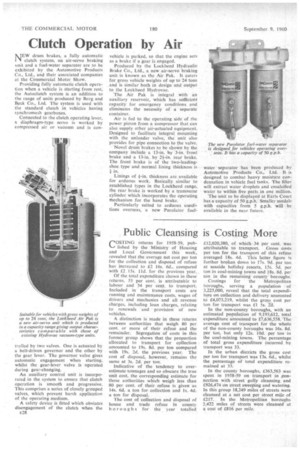Public Cleansing is Costing More
Page 86

If you've noticed an error in this article please click here to report it so we can fix it.
COSTING returns for 1958-59, pub lished by the Ministry of Housing and Local Government this week, revealed that the average net cost per ton for the collection and disposal of refuse has increased to E2 16s. 6d., compared with 12 15s. lid, for the previous year..
Of the total expenditure shown in these returns, 53 per cent, is attributable to labour and 34 per cent. to transport. Included in the transport costs are running and maintenance costs, wages of drivers and mechanics and all revenue charges, including loan charges, relating to renewals and provision of new vehicles.
A distinction is made in these returns between authorities that weigh 80 per cent, or more of their refuse and the remainder. Segregation of costs in this former group shows that the proportion allocated to transport for collection amounted to 19s. 8d. per ton compared with 19s. 2.1, the previous year. The cost of disposal, however, remains the same at 3s. 2d. per ton.
Indicative of the tendency to overestimate tonnages and so obscure the true unit cost, the corresponding estimate for those authorities which weigh less than 80 per cent, of their refuse is given as 14s. 6d. a ton for collection and Is. 4d. a ton for disposal.
The cost of collection and disposal of house and trade refuse in county boroughs for the year totalled £12,020,380, of which. 34 per cent, was attributable to transport. Gross costs per ton for the transport of this refuse averaged 18s. 4d. This latter figure is further broken down to 17s. 9d. per ton at seaside holiday resorts, 15s. 5d. per ton in coal-mining towns and 18s. 8d. per ton in the remaining county boroughs.
Costings for the Metropolitan boroughs, serving a population of 3,225,000, reveal that the total expenditure on collection and delivery amounted to £4,073,219, whilst the gross cost per ton for transport was £1 5s. 2a.
In the non-county boroughs, with an estimated population of 9,193,612, total expenditure amounted to f7,636,558. The average cost of transport for the whole of the non-county boroughs was 16s. 8d. per ton, but only 12s. 10d. per ton in the coal-mining towns. The percentage of total gross expenditure incurred by transport was 33.
In the urban districts the gross cost per ton for transport was 13s. 6d., whilst the percentage of total expenditure remained at 33.
In the county boroughs, £363,563 was spent in 1958-59 on transport in connection with street gully cleansing and £926,474 on street sweeping and watering. In this group 18,249 miles of streets were cleansed at a net cost per street mile of £217. In the Metropolitan boroughs 2,422 miles of streets were cleansed at a cost of £816 per mile.




















































































































































